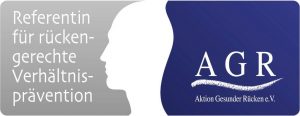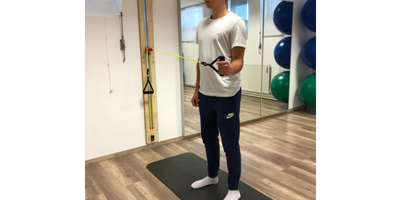The TOGU® Tower offers a variety of ways to effectively train your muscles. Together with the matching Theragym Pro Set (red = strong – green = medium – yellow = light) both training units for the recreational athletes and for athletes can be optimally executed and supplemented. By variations with additional equipment, e.g. TOGU® Powerball® ABS®, you can change, complicate and simplify exercises. In addition, the balance with activation of deep, joint-stabilizing muscles is specifically trained. The sitting position should be in the front third of the ball and the thighs fall slightly downwards. A big plus is the possibility of individual adjustment of the tower for each individual and the consequent optimization of the training for the exerciser. With the strength of the chosen band, it should be possible to repeat at least 8-12 reps in 2 sets to train strength endurance. Taking into account the training principles should therefore rather be started with a not too strong band and take an appropriate increase in order to control the quality of the exercise execution. Important: Always do all exercises on both sides!
Of course you always start in a correct starting position, because only then the exercise can be carried out properly. The training at the TOGU®Tower can improve the inter- and intra-coordinative abilities and thus movement sequences and the movement harmony. In addition, the self-stabilization is required in all levels of motion. The constant basic tension of the band and tension of the controlled muscles during an exercise, the joints are secured as possible. With the automatically required body tension and the core muscles is trained optimally.
There should be no jerky but steady movements. From a slight basic tension, the tape is pulled slowly, held for a breath in the final position and then just as slowly moved back to the starting position. While practicing, always pay attention to a steady and steady breathing.
The following exercise ideas appeal to healthy people. If problems occur in the various areas of the body or pain, the exercise must be stopped. In cases like these, a doctor or therapist should be consulted for clarification. There can be no liability on my part. Warm up sufficiently before the exercises. A light cardiovascular workout, mobilize the joints and stretching, then it can go already!
Have fun!
Below is a small selection of exercises with details of the main working muscles and short descriptions of execution and possible sources of error.
Rotatorenmanschette
The 4 muscles of the rotator cuff function as internal and external rotators of the arm in the shoulder joint and are also involved in almost all other arm movements. External rotating muscles include the supraspinatus muscle, the infraspinatus muscle, the teres minor muscle and the internal rotator of the subscapularis muscle, which originates at the front of the scapula.
internal rotation
Setting Tower: Band at elbow height
Starting position: lateral position to the tower. The upper arm is fixed on the body, the forearm points forward and the palm of the hand to the body. Execution: exhale slowly and bring the forearm inwards to the body. After a short stop, return to the starting position.
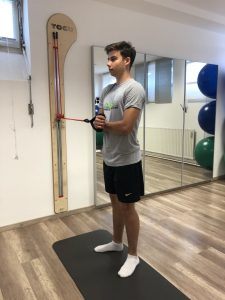
external rotation
Here are two very effective exercises on the tower:
Exercise 1: Lateral position to the tower. The outer upper arm is fixed to the body, the forearm forward and the palm to the body. Without compensating movement in the trunk or pulling up the shoulder, rotate the forearm as far as possible outwards, then back to the starting position.
This exercise is often done with weights standing up, and then usually more to the biceps than the external rotators, since the weight must be held against gravity.
Tip: Clamp a towel etc. between upper arm and upper body.
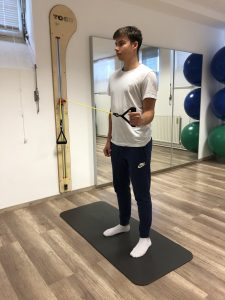
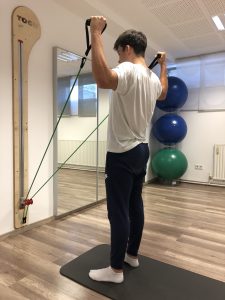
In Exercise 2, the upper arms are raised approximately at shoulder level and the arms are flexed. The forearms are pointing towards the tower, palms down. With the exhalation, the forearms are raised over the front and the shoulder blades are pulled downwards and slightly inwards at the same time.
Armstrider – M. Triceps
Starting position: face the tower frontally or e.g. sitting on the powerball. The upper arms are on the body.
Execution: Extend the forearms while inhaling. Hold the stretch while exhaling, then return to the starting position.
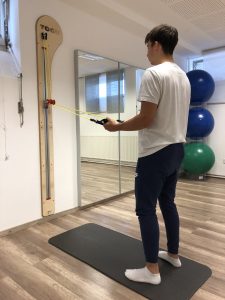
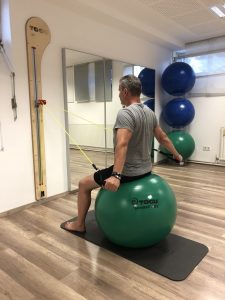
Armbender – M. Biceps
Starting position with almost straight arms. Flex the elbows alternately and hold the upper arm to the body.
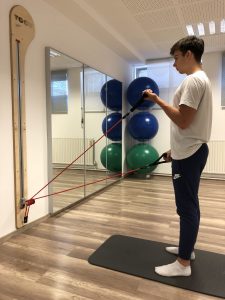
Abdominal training
In combination e.g. With the TOGU® Powerball ABS exercises for the abdominal muscles can also be performed well for people who are less comfortable on the floor.
Predominantly oblique abdominal muscles:
Setting Tower: Band in the center or at shoulder height
Starting position: Sitting sideways to the tower on the Powerball, the hands hold both handles together. The knees point towards the toes.
Execution: Exhaling with trunk rotation, slowly pull the bands aside, hold for a moment, then return to the starting position. The concentration in the movement phase is on the contraction of the abdominal muscles from the waist towards the pubic bone, i. with the idea “the hand reaches into the trouser pocket”
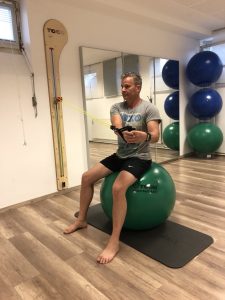
Variation while standing. The band from above:
Main musculature here is also the oblique abdominal musculature, u.a. in addition, the quadrilateral lumbar muscle and an elongation of the lateral trunk muscles on the yielding side.
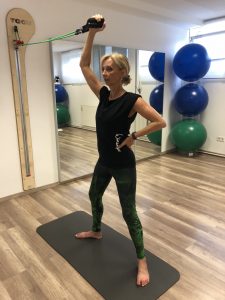
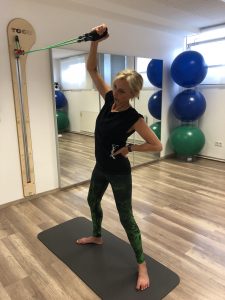
Diffraction with a long spine and a stretched neck.
Mainly straight abdominal muscles:
Tower setting: grab straps at head height from behind
Starting position: at knee level
Execution: Hold the straps with bent arms under slight basic tension.
Slowly curl up the torso with exhalation and approximate the sternum to the pubic bone. Do not pull with your arms. The flexion is performed slowly and segmentally with focus on the (predominantly) straight abdominal muscles!
In the final position, stop the flexion for a short time or pull the ligaments down in mini motions several times with small abdominal muscle impulses. Keep breathing while breathing. Then return to the starting position.
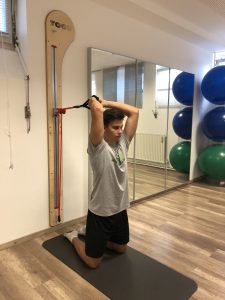
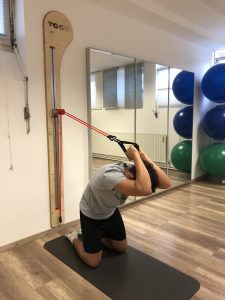
M. latissimus dorsi – Broad back muscle
The broad back muscle has important functions, e.g. Arm movements, both in everyday and sports activities and should therefore be considered in training. A great exercise for this muscle, which also u.a. the back part of the deltoid muscle, the biceps and in the final phase when the shoulder blades approach the hood and rhomboid muscles, rowing
Starting position: Sitting frontal to the tower with straight arms, the shoulder is internally rotated. Keep the belts in basic tension. Inhaling, bend your arms, tighten the straps, and straighten your back. Put your elbows behind the hull as far as possible. Exhale, then slowly return to the starting position. Perform the exercise with flowing movements. “Like in a rowboat!”
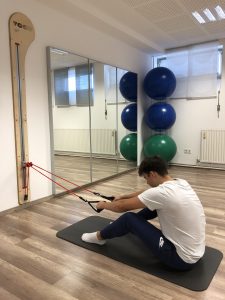
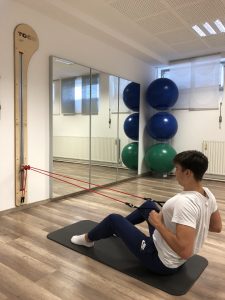
Autorin:
Claudia Hölzl
